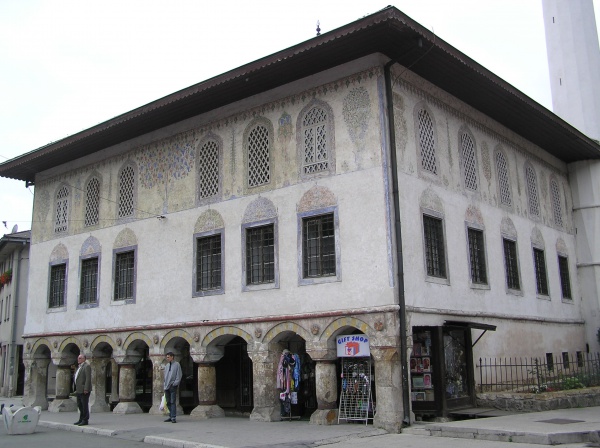Did you know that there is an unusual historical mosque – the Suleymaniye Mosque - in Bosnia? Its second name is “Adorned Mosque” gained for a particular reason. It is located in the very heart of an oasis of Islam in Southeast Europe – in the city of Travnik, Bosnia. The mosque was open for visitors not so long ago.

This mosque is probably one of the most important attractions and distinguished from other places of worship by its colorful decoration, abundance of frescoes on the façade and many elements of Islamic art typical of the Ottoman Empire.
It is noteworthy that the Suleymaniye Mosque is the only mosque in Bosnia, the minaret of which rises on the left side of the building. The mosque that can be seen today is the result of its reconstruction after a major fire in 1815. However, the original architectural style dates back to 1757. At that time the building of Islamic culture was called the Chamilia Mosque as it was built with the money of Vizier Sopa Salan Chamil Ahmed Pasha. But there is some information that the mosque dates back to the XVI century.
A lot of time has passed since that time. Unfortunately, the colors have faded, but the building has still not lost its uniqueness and attractiveness. The main feature of the building is a mini bazaar built into a stone arcade (it is called bezistan).
Bosnia and Islam
Islam first appeared in the Balkans after a large part of the peninsula was conquered by the Ottoman Empire. The Ottomans conquered Bosnia in 1463. Within a few centuries of occupation, part of the Southern Slavs had converted to Islam. Bosnia and Herzegovina remained part of the Ottoman Empire for several centuries until the Berlin Congress, held in 1878, transferred control over the Austria-Hungary region. In 1908, Austria-Hungary annexed the region. It led to the international conflict.
It is believed that the Balkan peoples converted to Islam only under pressure from the Turkish authorities in order to avoid certain taxes levied on all non-Muslim peoples of the Sublime Porte. However, as it typical, after the fall of the last Caliphate, this religion was preserved among the peoples of Bosnia and Herzegovina. It should be taken into account that during the Ottoman Caliphate years, Turks, Arabs, Kurds, representatives of Caucasian peoples moved here from other provinces of the empire. All of them participated in the formation of the present Bosnians and their culture.
For Bosnians, religion often serves as an identifier of their community, but religious practice is limited to occasional visits to a mosque or significant ceremonies: birth, marriage and death.
It should be noted that Bosnia and Herzegovina remains a secular country, roughly like Turkey, Azerbaijan and Central Asian countries. Here Islam is more a religious-cultural identity of the residents than a fundamental principle of organizing social life, as in Iran.
There is a certain percentage of women with covered head; many mosques are functioning and Islamic souvenirs are sold everywhere. In the very center of the city, there are embassies of Turkey and Iran, in the main street there is the Iranian Cultural Centre, a fair of books devoted to Ramadan.
The uniqueness of this Balkan country is that Bosnian Muslims are of Slavic origin and speak the language very close to Ukrainian and Russian. It is quite an extraordinary combination.
Fleeing the destruction
By some miracle, the Suleymaniye Mosque has managed to survive the cultural genocide that broke out against Bosnian mosques and attractions during the war of independence in 1992-1995. As a result of that tragedy, the majority of buildings were damaged or completely destroyed, with up to 80% of the more than 4000 pre-war Islamic structures and mosques affected.
According to the UNESCO and “The Commission to Preserve National Monuments of Bosnia”, mass destruction has resulted in the loss of most of the unique Islamic places of worship and attractions.
After gaining independence in 1992, Bosnia became the leader among the countries visited in the Balkan region. If we refer to the results of 2013, we will find out that Islam remains here the main religion – it is practiced by 51% of the population. There are eight Muftis in the large municipalities of Sarajevo, Bihac, Travnik, Tuzla, Gorazde, Zenica, Mostar and Banja Luka.
Ilmira Gafiyatullina
Photo: Meyavuz/Creative Commons
